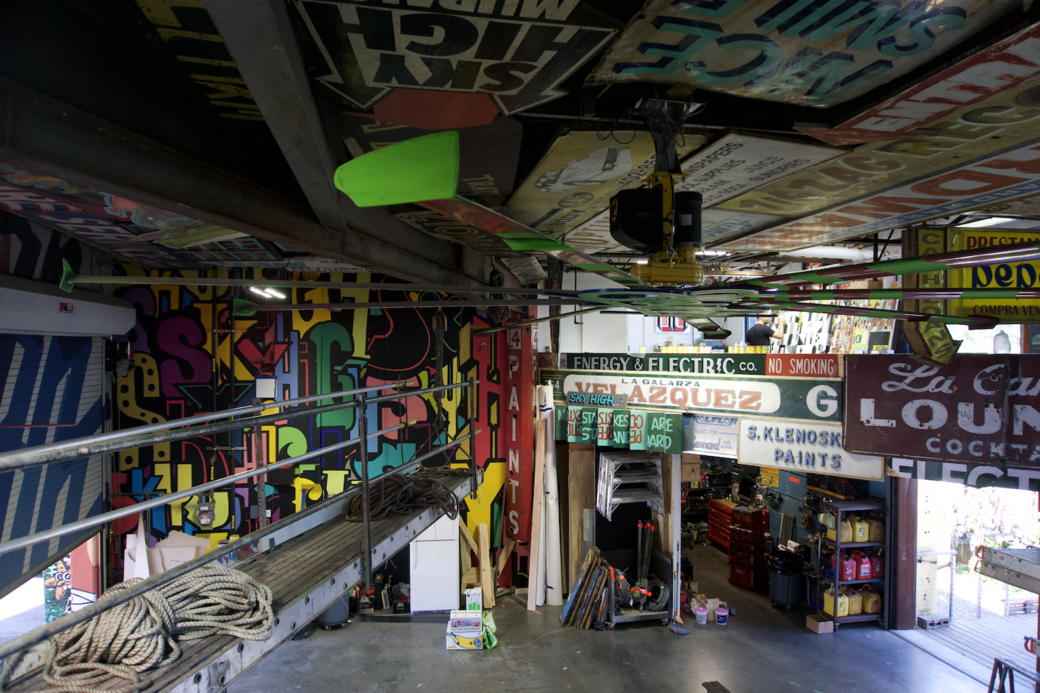On the corner of Bogart and Grattan, a 20-foot-tall woman in a blue and white striped dress looks like she spotted something exciting. That thing is probably the bottle of Peroni this advertisement is for.
At first glance, the ad looks like every other one: a vinyl poster with an attractive photo and catchy text. But at closer examination, it’s clear that this one is painted. The company behind this mural—and three others in Bushwick—is Colossal Media, which hand paints murals for brands that are looking to give their advertisements a special touch. This year, they’re celebrating their 15th anniversary.
“Ads are all about getting people’s attention,” said Paul Lindahl, one of Colossal Media’s founders. “That’s what our murals do like no other type of modern advertising. People stop walking, look up, and take photos of our work, which is really hard to achieve. Especially in New York City.”
In this fast-paced, digital age, hand painting an ad sounds like a counterintuitive thing to do: it takes a lot of time and there are numerous ways to advertise faster, cheaper, and more targeted.

“When you ask people ‘do you like ads?’ They will say, ‘no,’” said Lindahl. “But we bring honest value to them.” A lot of humanity goes into these ads, like physical labor and creativity. People love to experience the creation of the murals. It takes people back to simpler times, a sentiment that goes hand-in-hand with the recent surge of interest in DIY culture, artisanal food, and small-batched items.
As a company that blurs the lines between art and commerce, Colossal has had to deal with some critique and even vandalism. Some people think they take away opportunities for artists, because they have the money to use certain walls.
“For the most part, people appreciate what we do,” said Nicole Greco-Lucchina, the assistant pre-production manager. “But there is a small fraction of people who say, ‘fuck the [corporate] man,’ and to them, we’re the man.”
Greco-Lucchina and her colleagues—studio manager Ann Hyett and operations manager James Zepf—deduce that, if their murals weren’t there, those walls would’ve probably been covered in large vinyl posters. This way, they beautify the walls while employing artists.

“And sign painting is an older art form than graffiti,” said Darius Dennis, an apprentice at Colossal, “we’re just bringing it back.”
Dennis started his apprenticeship about seven months ago. The apprenticeship lasts one year and is just the first of five levels of Wall Dog, as the muralists call themselves.
“Because we use paint, people assume what we do is a lot more delicate,” said Dennis. “But 60 percent of our job is like construction work. The real rigor rests in rigging the walls ourselves. It’s hard work and you need to be tenacious.”
Working hard and having an everything-is-possible attitude are part of Colossal’s DNA. Underneath a practice scaffold inside the high-ceiling equipment space, the team talks about this attitude. They work 365 days a year, think no wall is too hard to work with, and don’t get held back by weather—unless the walls are too wet for the paint to stick.

“So the WOMB is basically on constant weather watch,” said Greco-Lucchina. The “WOMB” (work operations management bureau) is a room upstairs with views of the Manhattan skyline, where operations management oversees the projects’ development. They are in constant contact with the people at their Williamsburg HQ, which hosts, among others, the sales team, the marketing team and real estate team.”
The top floor is also where the pre-production team starts projects. They use a technique that has been around for centuries—it was famously used by Michelangelo when he painted the Sistine Chapel. They divide the image into blocks of 4-by-8 feet on the wall and draw a rough outline.
In a dark room one floor down, this outline is projected on paper of the same size, and traced with a big marker and a laser that creates tiny holes in the paper. On the wall, the Wall Dogs will dab bags of charcoal onto the holes, which leaves a subtle outline of the image.

“It is very important that we do a precise job here,” said Greco-Lucchina. “If we make a mistake, things could go like in a telephone game where the end result on the wall looks nothing like the original picture.”
Another vital element to precisely recreating ads is mixing paint to match the original colors. This happens in a room with a greenhouse roof that allows Wall Dogs to mix by daylight. Lindahl mixes a bright blue with white to match the bottles on a vodka brand’s ad. To make sure the color is right, he dabs little dots of paint on a print of the ad.
“To stay relevant, we have to keep improving,” Lindahl said. “Every mural has to be better than the last.” Right now, that means that they’re following the trends and exploring glitter paint.

All images courtesy of author, unless otherwise specified.
For more news, sign up for Bushwick Daily’s newsletter.



